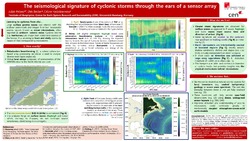The seismological signature of cyclonic storms through the ears of a sensor array
2021Poster
Englisch
Förderer: Universität Hamburg
 |
Dokument öffnen: |
Under certain conditions, ocean surface gravity waves (SGW) interact with the seafloor underneath to trigger
relatively faint but measurable seismic waves known as ocean microseisms. Cyclonic storms (e.g.
hurricanes, typhoons) wandering over the ocean are major (non-stationary) sources of the former, thus
opening the possibility of tracking and studying cyclones by means of their corresponding microseims.
For this purpose, we identified storm-related microseisms hidden in the ambient seismic wavefield via array
processing. Polarization beamforming, a robust and well-known technique is implemented. The analyses
hinge on surface waves (Love and Rayleigh) which, in contrast to P-waves, are stronger but only constrain
direction of arrival (without source remoteness). We use a few land-based virtual seismic arrays surrounding
the North Atlantic to investigate the signatures of major hurricanes in the microseismic band (0.05-0.16 Hz),
in a joint attempt to continuously triangulate their tracks.
Our findings show that storm microseisms are intermittently excited with modulated amplitude at localized
oceanic regions, particularly over the shallow continental shelves and slopes, having maximum amplitudes
virtually independent of storm category. In most cases no detection was possible over deep oceanic regions,
nor at distant arrays. Additionally, the rear quadrants and trailing swells of the cyclone provide the optimum
SGW spectrum for the generation of microseisms, often shifted more than 500 km off the "eye".
As a result of the aforementioned and added to the strong attenuation of storm microseisms, the inversion of
tracks or physical properties of storms using a few far-field arrays is discontinuous in most cases, being
reliable only if benchmark atmospheric and/or oceanic data is available for comparison.
Even if challenging due to the complexity of the coupled phenomena responsible for microseisms, the
inversion of site properties, such as bathymetric parameters (e.g. depth, seabed geomorphology), near-
bottom geology or SGW spectrum might be possible if storms are treated as natural sources in time-lapse
ambient noise investigations. This will likely require near-field (land and underwater) observations using
optimal arrays or dense, widespread sensor networks. Improved detection and understanding of ocean
microseisms carries a great potential to contribute to mechanically coupled atmosphere-ocean-earth models.

